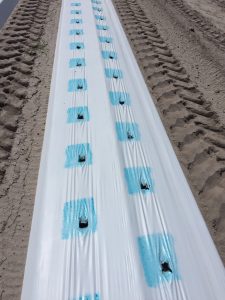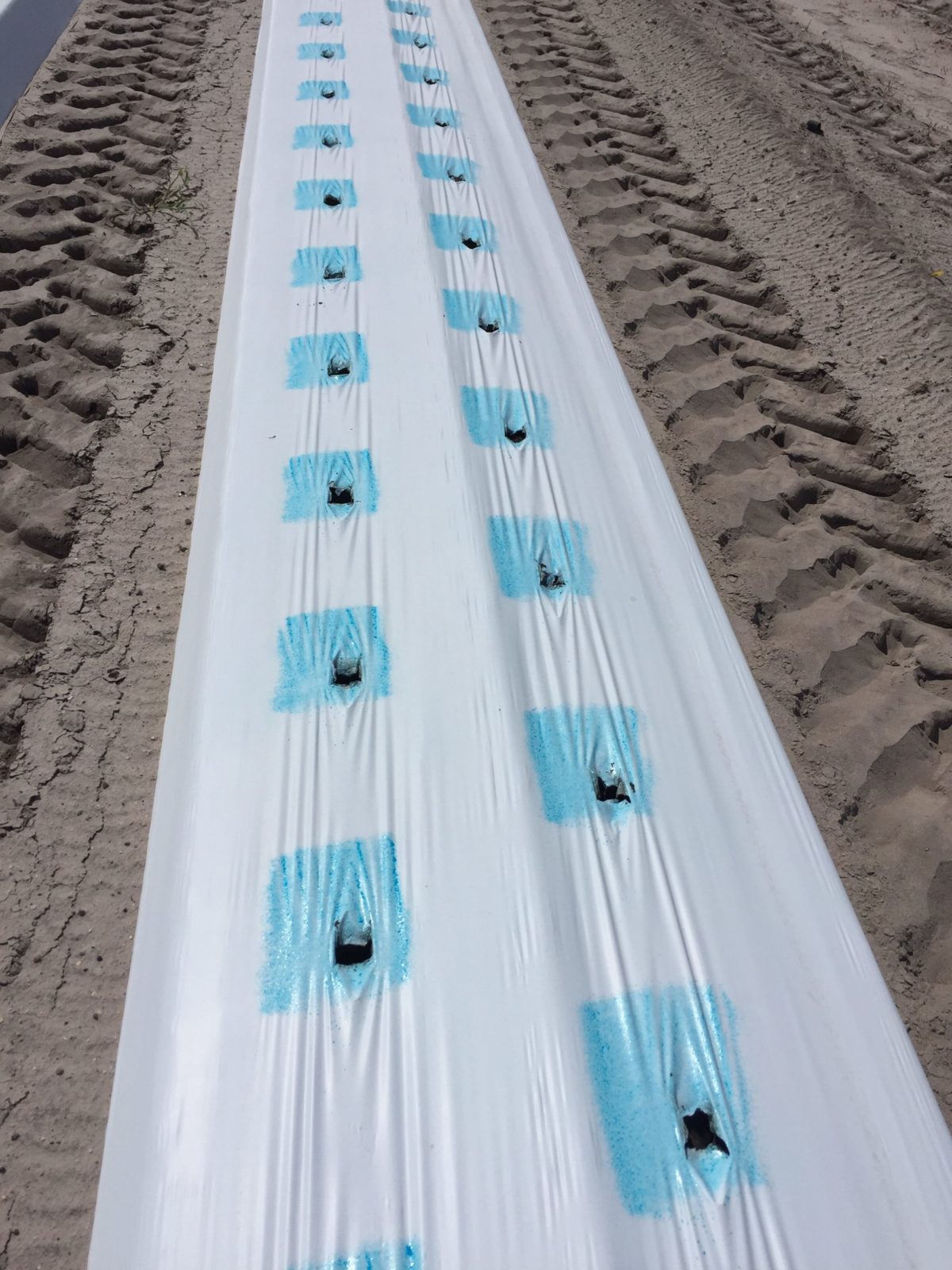
Blue dye was added to the herbicide spray to show the specific area around transplant holes that gets treated with the precision-application technology.
By Nathan S. Boyd and Arnold Schumann
The majority of vegetables grown in Florida are grown on raised, fumigated beds covered with plastic mulch. This production technique has been widely adopted because the combination of plastic mulch and drip tape improves water and fertility efficiency. The use of plastic mulches has many additional benefits, including improved crop quality, reduced water loss from the soil, soil temperature modification and improved weed control.
Historically, vegetable growers fumigated the soil prior to laying the plastic mulch with methyl bromide to control soil-borne pests, including weeds, insects, nematodes and pathogens. Methyl bromide was banned and can no longer be used by vegetable growers. As a result, they have switched to a variety of alternative fumigants. The majority of the alternative fumigants do not control as broad of a spectrum of pests and tend not to adequately control broadleaf weeds and grasses.
CURRENT PRACTICES
To address the lack of weed control, a growing number of small fruit and vegetable growers have begun to apply pre-emergent herbicides to the bed top following fumigation and immediately prior to installing plastic mulch. In most cases, growers apply the herbicides using spray equipment attached to bed press equipment or they use a separate sprayer.
The pre-emergent herbicides used vary with the crop and grower preference. For example, strawberry growers tend to use Chateau (flumioxazin) or a tank mix of Goal 2XL (oxyfluorfen) and Devrinol (napropamide), whereas tomato growers tend to use products like Dual Magnum (S-metolachlor) or TriCor (metribuzin).
The use of pre-emergent herbicides can effectively reduce the number of weeds that emerge in the planting hole with the transplant. However, the herbicides are almost always applied to the entire bed top despite the fact that broadleaf and grass weeds cannot puncture the plastic mulch. This means they can only emerge where the mulch is punctured to place the vegetable transplant in the ground. As a result, a large portion of the herbicide applied is not needed because it is applied where weeds cannot emerge. Application of herbicides only where the plastic is punctured would dramatically decrease herbicide use.
PROMISING PRELIMINARY RESULTS
Combining forces to address this problem, we evaluated precision herbicide-application technology capable of applying pre-emergent herbicides only to the transplant hole at the time when the mulch is punctured in preparation for transplant. The technology can be used in conjunction with standard hole-punch equipment to reduce the number of trips in the field.
Preliminary results found that this technology can safely be used on tomatoes and peppers. No crop damage or yield reductions were observed in preliminary experiments. In addition, no differences in weed control were observed despite an 88 to 91 percent reduction in herbicide use.
Experiments are ongoing, but early results suggest that it is possible to substantially reduce herbicide use by applying the herbicides only where they are needed. This type of technology will benefit growers by reducing application costs while enhancing the environment via reduced agrochemical inputs.
Nathan S. Boyd is an associate professor at the University of Florida Institute of Food and Agricultural Sciences (UF/IFAS) Gulf Coast Research and Education Center in Wimauma. Arnold Schumann is a professor at the UF/IFAS Citrus Research and Education Center in Lake Alfred.
See more articles like this in VSCNews magazine. Click here to subscribe.
Share this Post










